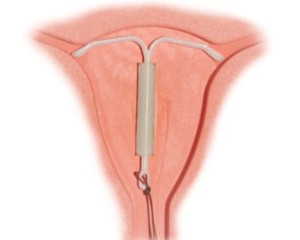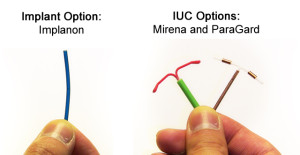This is a picture of an IUD in a mockup of a uterus.
The potential of LARCs (Long Acting Reversible Contraception) is so great that I am advocating that all voters advocate for them to be paid for by government. The savings–both financial and in terms of human potential–are enormous!
Your doctor tells you that she can prescribe either of two treatments, but that one is 20 times as likely to fail as the other. Which would you choose?
Over a quarter of women in the USA use birth control pills, which fail much more frequently than Long Acting Reversible Contraception. LARCs, as they are nicknamed, are amazingly effective yet not used as frequently as one might hope.
IUDs (Intrauterine Devices) are the most commonly used LARCs. There are four available now; they are all made out of flexible plastic in the shape of a “Tâ€. Three emit a tiny amount of hormone into the woman’s uterus, where it is most effective. The fourth IUD uses copper to gain effectiveness. IUDs are usually well tolerated, although sometimes they can increase cramps or change menstrual flow. The best medical knowledge is that IUDs do not work by aborting pregnancies.
IUDs can stay in place for a maximum of 3 to 10 years, depending on which type. Since there is a string attached, they are usually easy to remove. The string also allows the woman to check that it is in the correct place. The pregnancy rate is vanishingly small—only a couple of LARC users in 1,000 will conceive each year. This statistic for “the pill†is much higher—almost 50 per thousand will experience an unplanned pregnancy. Apparently the high failure rate of oral contraceptives in the USA is due to noncompliance. In Europe the failure rate is significantly lower; European women take their birth control pills more regularly.
There are two major drawbacks to both IUDs and the implant: they are expensive and they need to be placed by an experienced clinician. IUDs have a further drawback—bad press.
It used to be that only women with health insurance or a plump checking account could afford LARCs, but that is changing. Thanks to the Affordable Care Act (“Obamacareâ€), any woman with insurance, including Medicaid, can get her chosen birth control without copay. In addition, one IUD, Liletta®, is priced much lower than the others. Here in Colorado there is a program that provides contraception, including LARCs, at little or no cost.
Placing an IUD is not difficult for a trained practitioner. The opening of a woman’s cervix may be tight is she hasn’t borne a child, but a little local anesthesia and gentle dilatation will help with the insertion.
The other type of LARC is the implant, Nexplanon®, which is as effective as an IUD. It is a thin plastic rod that is inserted under the skin of the woman’s arm, where it can stay for up to 3 years. It emits a hormone that is very effective in preventing pregnancy. Although it is in a very low level in the woman’s blood, it is sufficient to change menstrual patterns; most women with Nexplanon® will have spotting or breakthrough bleeding. Perhaps this is why less than 1% of women in the USA choose an implant, whereas about 6% use an IUD.
Unfortunately, reproductive health has become a political football. Here in Colorado a grant demonstrated that access to LARCs can give young women a better chance in life by decreasing teen pregnancies. By taking away the consideration of expense, the use of LARCs expanded 4 fold. Nevertheless, the false fear that IUDs might abort pregnancies kept our legislators from continuing funding to provide this effective contraception. The best way to prevent abortions is with effective birth control!
Ohio took a tip from Colorado with a program to provide LARCs. Part of that state’s motivation is to lower their infant mortality rate. They are targeting young teens and women who have just had a child, since these two groups are at high risk of having an infant die if they were to get pregnant. They also note that the state saves almost $6 for every dollar invested in LARCs.
Ohio has been proactive in another way. Some healthcare providers have misconceptions about IUDs. They think that they should only be used if a woman already has delivered a baby, or that an IUD makes a woman more susceptible to sexually transmitted infections, or teens shouldn’t use IUDs, or that IUDs can lead to sterility. All of these perceptions are wrong! Indeed, almost every woman can safely use an IUD, and start her family as soon as it is removed.
Safe, effective contraception is an important step in empowering women. We should advocate for making LARCs available to all women!
© Richard Grossman MD, 2016

